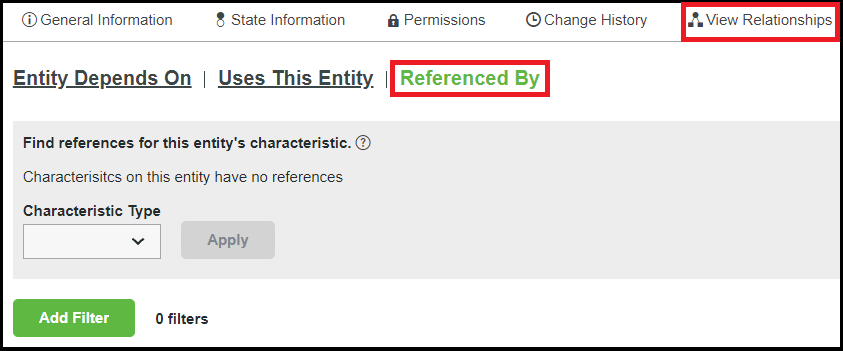Referenced By
The Referenced By feature allows you to view an entity's relationships in ThingWorx. You can determine where an entity or its characteristics, such as a service or property, are used in ThingWorx. This can be useful if you need to make changes to entities, and need to know what effects your changes will have elsewhere in your model. This functionality is also available as a service, see Using the GetWhereUsed Service for more information.
|
|
Referenced By is available in ThingWorx 9.3 and later.
|
Enabling Referenced By
The Referenced By feature is disabled by default. To enable this feature, go to the Relationship Subsystem, and in the Configuration section, select Enable Referenced By, and Save.
Once enabled, the Referenced By feature is available for the following entity types in ThingWorx in the View Relationships tab for the entity: Data Shapes, Data Tables, Gadgets, Industrial Connections, Integration Connectors, Mashups, Masters, Media, Menus, Schedulers, State Definitions, Streams, Style Definitions, Style Themes, Thing Shapes, Thing Templates, Things, Timers, and Users. 

Referenced By Results
If references exist for an entity, the results display in a table. If there are references for the entity's characteristics, you can filter by the characteristic type. Characteristic types are services, properties, events, and localization tokens. The Characteristic Type drop down only displays types that have references for that entity, and the types are:
• Property— Properties that reference the entity. If selected, a list of characteristic names displays to select from.
• Service/Event— Services and events that reference the entity. If selected, a list of characteristic names displays to select from.
• Any— Includes any characteristic types that contain references.
• None— Resets the Characteristic Type selection that shows the references on the entity directly.
It is possible to have a reference that isn't captured in results. For example, if an entity name is stored in a variable and is used within a service definition. System objects are also not part of Referenced By results. |

Filtering
You can also filter Referenced By results by the following:
• Entity Name — The name of the entity.
• Entity Type — The type of entity. The available types are Application Key, Authenticators, Dashboards, Data Shapes, Data Tags, Directory Services, Localization Tables, Mashups, Media, Menus, Model Tags, Networks, Notifications, Organizations, Projects, State Definitions, Style Definitions, Style Themes, Subsystems, Things, Thing Groups, Thing Shapes, Thing Templates, Users, User Groups.
• Location Name — The name of the location where the characteristic reference exists. For example, the name of a service or event.
• Project — The name of the project.
• Reference Location — Where the characteristic reference exists. The available types are Base Thing Template, Configuration, State Definition: Custom, Data Shape, State Definition: Default, Project Dependency, Design Time Permission, Event, Field Definition, Home Mashup, Implemented Thing Shape, Instance Design Time Permission, Instance Run Time Permission, User Language, Form Login Button Style, Mashup Data, Mashup Parameter, Mashup, Members, Menu Definition, Menu Item, Mobile Mashup, Network Hierarchy, Password Reset Mail Server, Persistence Provider, Property, Run As User, Run Time Permission, Service Script, Service, Content Crawler Thing, Style Information, Subscription, Tags, Notification Trigger, User Name Reference, Value Stream, Visibility Permission.
Permissions
A non-administrator user can use the Referenced By feature but may not be able to view all results if they don't have permissions to view certain entities or characteristics. In this case, an administrator user can view the Security log, which displays the first 50 entities that the non-administrator user is unable to view, and change permissions accordingly.